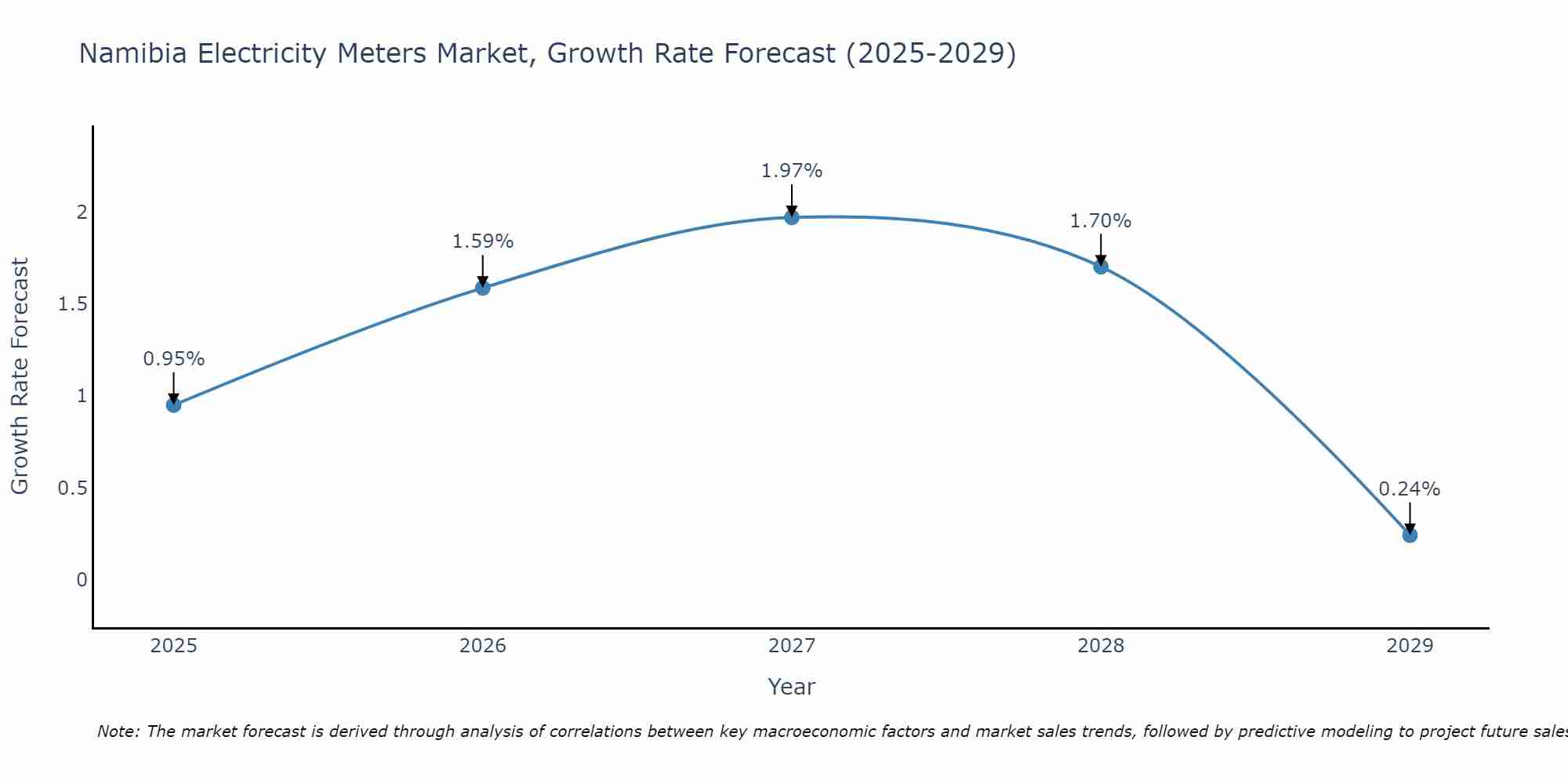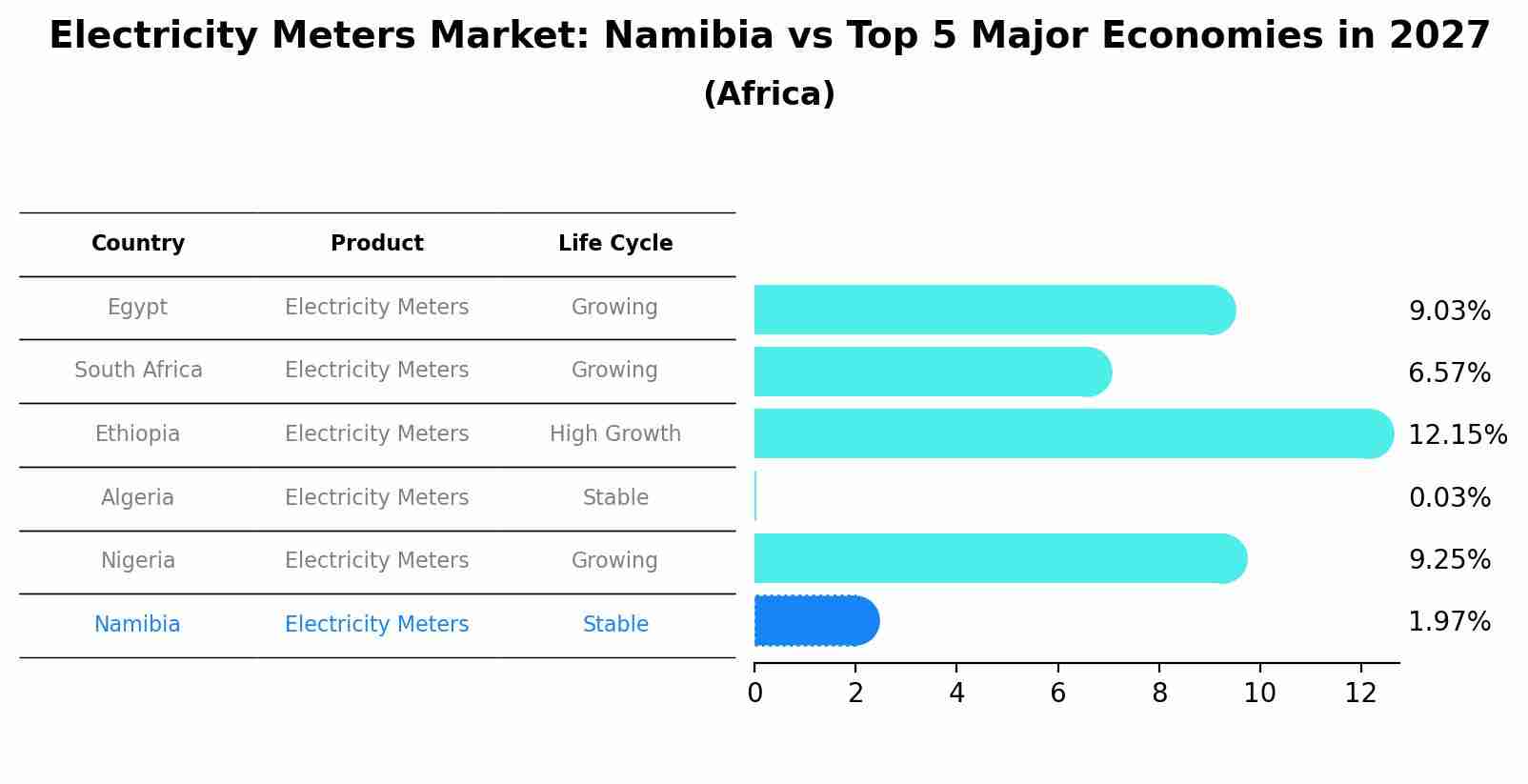Namibia Electricity Meters Market (2025-2031) | Companies, Growth, Analysis, Industry, Share, Value, Outlook, Size, Segmentation, Revenue, Trends & Forecast
| Product Code: ETC5407589 | Publication Date: Nov 2023 | Updated Date: Oct 2025 | Product Type: Market Research Report | |
| Publisher: 6Wresearch | No. of Pages: 60 | No. of Figures: 30 | No. of Tables: 5 | |
Namibia Electricity Meters Market Size Growth Rate
The Namibia Electricity Meters Market is projected to witness mixed growth rate patterns during 2025 to 2029. The growth rate begins at 0.95% in 2025, climbs to a high of 1.97% in 2027, and moderates to 0.24% by 2029.

Electricity Meters Market: Namibia vs Top 5 Major Economies in 2027 (Africa)
The Electricity Meters market in Namibia is projected to grow at a stable growth rate of 1.97% by 2027, highlighting the country's increasing focus on advanced technologies within the Africa region, where Egypt holds the dominant position, followed closely by South Africa, Ethiopia, Algeria and Nigeria, shaping overall regional demand.

Key Highlights of the Report:
- Namibia Electricity Meters Market Outlook
- Market Size of Namibia Electricity Meters Market, 2024
- Forecast of Namibia Electricity Meters Market, 2031
- Historical Data and Forecast of Namibia Electricity Meters Revenues & Volume for the Period 2021-2031
- Namibia Electricity Meters Market Trend Evolution
- Namibia Electricity Meters Market Drivers and Challenges
- Namibia Electricity Meters Price Trends
- Namibia Electricity Meters Porter`s Five Forces
- Namibia Electricity Meters Industry Life Cycle
- Historical Data and Forecast of Namibia Electricity Meters Market Revenues & Volume By Type for the Period 2021-2031
- Historical Data and Forecast of Namibia Electricity Meters Market Revenues & Volume By Single Phase for the Period 2021-2031
- Historical Data and Forecast of Namibia Electricity Meters Market Revenues & Volume By Three Phase for the Period 2021-2031
- Historical Data and Forecast of Namibia Electricity Meters Market Revenues & Volume By Analog for the Period 2021-2031
- Historical Data and Forecast of Namibia Electricity Meters Market Revenues & Volume By Smart for the Period 2021-2031
- Historical Data and Forecast of Namibia Electricity Meters Market Revenues & Volume By Application for the Period 2021-2031
- Historical Data and Forecast of Namibia Electricity Meters Market Revenues & Volume By Residential for the Period 2021-2031
- Historical Data and Forecast of Namibia Electricity Meters Market Revenues & Volume By Commercial for the Period 2021-2031
- Historical Data and Forecast of Namibia Electricity Meters Market Revenues & Volume By Industrial for the Period 2021-2031
- Historical Data and Forecast of Namibia Electricity Meters Market Revenues & Volume By Others for the Period 2021-2031
- Namibia Electricity Meters Import Export Trade Statistics
- Market Opportunity Assessment By Type
- Market Opportunity Assessment By Application
- Namibia Electricity Meters Top Companies Market Share
- Namibia Electricity Meters Competitive Benchmarking By Technical and Operational Parameters
- Namibia Electricity Meters Company Profiles
- Namibia Electricity Meters Key Strategic Recommendations
Frequently Asked Questions About the Market Study (FAQs):
1 Executive Summary |
2 Introduction |
2.1 Key Highlights of the Report |
2.2 Report Description |
2.3 Market Scope & Segmentation |
2.4 Research Methodology |
2.5 Assumptions |
3 Namibia Electricity Meters Market Overview |
3.1 Namibia Country Macro Economic Indicators |
3.2 Namibia Electricity Meters Market Revenues & Volume, 2021 & 2031F |
3.3 Namibia Electricity Meters Market - Industry Life Cycle |
3.4 Namibia Electricity Meters Market - Porter's Five Forces |
3.5 Namibia Electricity Meters Market Revenues & Volume Share, By Type, 2021 & 2031F |
3.6 Namibia Electricity Meters Market Revenues & Volume Share, By Application, 2021 & 2031F |
4 Namibia Electricity Meters Market Dynamics |
4.1 Impact Analysis |
4.2 Market Drivers |
4.2.1 Government initiatives promoting energy efficiency and renewable energy sources |
4.2.2 Increasing urbanization and industrialization leading to higher electricity consumption |
4.2.3 Growing awareness about the importance of energy conservation and cost management |
4.3 Market Restraints |
4.3.1 High initial costs of installing smart meters and related infrastructure |
4.3.2 Limited access to financing for metering projects in remote or low-income areas |
4.3.3 Regulatory challenges and policy uncertainty affecting investment decisions |
5 Namibia Electricity Meters Market Trends |
6 Namibia Electricity Meters Market Segmentations |
6.1 Namibia Electricity Meters Market, By Type |
6.1.1 Overview and Analysis |
6.1.2 Namibia Electricity Meters Market Revenues & Volume, By Single Phase, 2021-2031F |
6.1.3 Namibia Electricity Meters Market Revenues & Volume, By Three Phase, 2021-2031F |
6.1.4 Namibia Electricity Meters Market Revenues & Volume, By Analog, 2021-2031F |
6.1.5 Namibia Electricity Meters Market Revenues & Volume, By Smart, 2021-2031F |
6.2 Namibia Electricity Meters Market, By Application |
6.2.1 Overview and Analysis |
6.2.2 Namibia Electricity Meters Market Revenues & Volume, By Residential, 2021-2031F |
6.2.3 Namibia Electricity Meters Market Revenues & Volume, By Commercial, 2021-2031F |
6.2.4 Namibia Electricity Meters Market Revenues & Volume, By Industrial, 2021-2031F |
6.2.5 Namibia Electricity Meters Market Revenues & Volume, By Others, 2021-2031F |
7 Namibia Electricity Meters Market Import-Export Trade Statistics |
7.1 Namibia Electricity Meters Market Export to Major Countries |
7.2 Namibia Electricity Meters Market Imports from Major Countries |
8 Namibia Electricity Meters Market Key Performance Indicators |
8.1 Percentage increase in adoption of smart meters in urban areas |
8.2 Average time taken for meter installation and activation |
8.3 Percentage reduction in electricity losses due to improved metering accuracy |
8.4 Number of public-private partnerships in the electricity metering sector |
8.5 Percentage increase in energy savings attributed to smart meter installations |
9 Namibia Electricity Meters Market - Opportunity Assessment |
9.1 Namibia Electricity Meters Market Opportunity Assessment, By Type, 2021 & 2031F |
9.2 Namibia Electricity Meters Market Opportunity Assessment, By Application, 2021 & 2031F |
10 Namibia Electricity Meters Market - Competitive Landscape |
10.1 Namibia Electricity Meters Market Revenue Share, By Companies, 2024 |
10.2 Namibia Electricity Meters Market Competitive Benchmarking, By Operating and Technical Parameters |
11 Company Profiles |
12 Recommendations | 13 Disclaimer |
- Single User License$ 1,995
- Department License$ 2,400
- Site License$ 3,120
- Global License$ 3,795
Search
Related Reports
- ASEAN Bearings Market (2025-2031) | Strategy, Consumer Insights, Analysis, Investment Trends, Opportunities, Growth, Size, Share, Industry, Revenue, Segments, Value, Segmentation, Supply, Forecast, Restraints, Outlook, Competition, Drivers, Trends, Demand, Pricing Analysis, Competitive, Strategic Insights, Companies, Challenges
- Europe Flooring Market (2025-2031) | Outlook, Share, Industry, Trends, Forecast, Companies, Revenue, Size, Analysis, Growth & Value
- Saudi Arabia Manlift Market (2025-2031) | Outlook, Size, Growth, Trends, Companies, Industry, Revenue, Value, Share, Forecast & Analysis
- Uganda Excavator, Crane, and Wheel Loaders Market (2025-2031) | Strategy, Consumer Insights, Analysis, Investment Trends, Opportunities, Growth, Size, Share, Industry, Revenue, Segments, Value, Segmentation, Supply, Forecast, Restraints, Outlook, Competition, Drivers, Trends, Demand, Pricing Analysis, Competitive, Strategic Insights, Companies, Challenges
- Rwanda Excavator, Crane, and Wheel Loaders Market (2025-2031) | Strategy, Consumer Insights, Analysis, Investment Trends, Opportunities, Growth, Size, Share, Industry, Revenue, Segments, Value, Segmentation, Supply, Forecast, Restraints, Outlook, Competition, Drivers, Trends, Demand, Pricing Analysis, Competitive, Strategic Insights, Companies, Challenges
- Kenya Excavator, Crane, and Wheel Loaders Market (2025-2031) | Strategy, Consumer Insights, Analysis, Investment Trends, Opportunities, Growth, Size, Share, Industry, Revenue, Segments, Value, Segmentation, Supply, Forecast, Restraints, Outlook, Competition, Drivers, Trends, Demand, Pricing Analysis, Competitive, Strategic Insights, Companies, Challenges
- Angola Excavator, Crane, and Wheel Loaders Market (2025-2031) | Strategy, Consumer Insights, Analysis, Investment Trends, Opportunities, Growth, Size, Share, Industry, Revenue, Segments, Value, Segmentation, Supply, Forecast, Restraints, Outlook, Competition, Drivers, Trends, Demand, Pricing Analysis, Competitive, Strategic Insights, Companies, Challenges
- Israel Intelligent Transport System Market (2025-2031) | Strategy, Consumer Insights, Analysis, Investment Trends, Opportunities, Growth, Size, Share, Industry, Revenue, Segments, Value, Segmentation, Supply, Forecast, Restraints, Outlook, Competition, Drivers, Trends, Demand, Pricing Analysis, Competitive, Strategic Insights, Companies, Challenges
- Uganda Precast and Aggregate Market (2025-2031) | Strategy, Consumer Insights, Analysis, Investment Trends, Opportunities, Growth, Size, Share, Industry, Revenue, Segments, Value, Segmentation, Supply, Forecast, Restraints, Outlook, Competition, Drivers, Trends, Demand, Pricing Analysis, Competitive, Strategic Insights, Companies, Challenges
- Australia IT Asset Disposal Market (2025-2031) | Strategy, Consumer Insights, Analysis, Investment Trends, Opportunities, Growth, Size, Share, Industry, Revenue, Segments, Value, Segmentation, Supply, Forecast, Restraints, Outlook, Competition, Drivers, Trends, Demand, Pricing Analysis, Competitive, Strategic Insights, Companies, Challenges
Industry Events and Analyst Meet
Our Clients
Whitepaper
- Middle East & Africa Commercial Security Market Click here to view more.
- Middle East & Africa Fire Safety Systems & Equipment Market Click here to view more.
- GCC Drone Market Click here to view more.
- Middle East Lighting Fixture Market Click here to view more.
- GCC Physical & Perimeter Security Market Click here to view more.
6WResearch In News
- Doha a strategic location for EV manufacturing hub: IPA Qatar
- Demand for luxury TVs surging in the GCC, says Samsung
- Empowering Growth: The Thriving Journey of Bangladesh’s Cable Industry
- Demand for luxury TVs surging in the GCC, says Samsung
- Video call with a traditional healer? Once unthinkable, it’s now common in South Africa
- Intelligent Buildings To Smooth GCC’s Path To Net Zero













